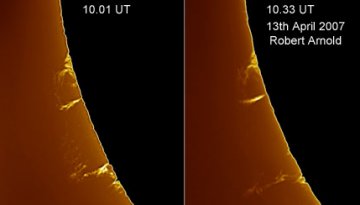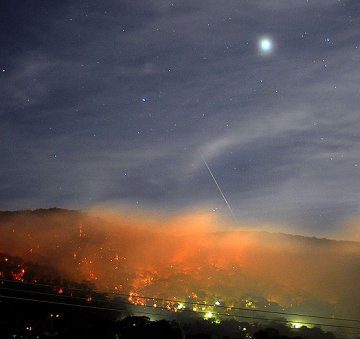 Did you miss last night's auroras? Next time get a wake-up call from Spaceweather PHONE.
Did you miss last night's auroras? Next time get a wake-up call from Spaceweather PHONE.
ASTEROID FLYBY: On April 16th, asteroid 2007 GU1 will fly past Earth. There's no danger of a collision. The 50 meter-wide space rock will be 500,000 miles away at closest approach, about twice the distance to the Moon. Interestingly, an asteroid about this size may have caused the Tunguska explosion of 1908. Such an impact occurs every thousand years or so, researchers believe. But not this time.
BLANK SUN: The sunspot number is zero for the 10th day in a row. If the sun remains devoid of spots for one more day, it will mark the longest string of blank suns since 1996. 1996 was a year of deep solar minimum, featuring blank intervals as long as 37 days. 2007 is shaping up the same--a nadir of the solar cycle.
Of course, blank is in the eye of the beholder. Although the sun has no spots, it has plenty of prominences. Robert Arnold photographed these today from the Isle of Skye, Scotland:

If you have a solar telescope, take a look!
more images: from John M. Candy of Whitley Bay, North Tyneside, UK; from Branden Morrissette and John Stetson of South Portland, Maine; from Monty Leventhal of Sydney. Australia; from Les Cowley of England.
LAST SHOT: Firefighters had just gotten a bushfire under control near Melbourne, Australia, on April 10th when homeowner Rob Carew beheld a planet beaming through the smoke--and he took this picture:

Photo details: Nikon D200, 24 mm lens, 400 ASA, 13 seconds.
"The fire looked amazing with Jupiter rising behind," says Carew. "And then Lady Luck threw in a meteor! Sadly, my camera lens fell to the ground and was ruined after this shot--a last lovely picture."
The scene could repeat itself on April 22nd and 23rd when the Lyrid meteor shower peaks. Early morning sky watchers will see as many as 18 meteors per hour flashing around the planet Jupiter. Hopefully, the fire will be out by then. Stay tuned for details.

